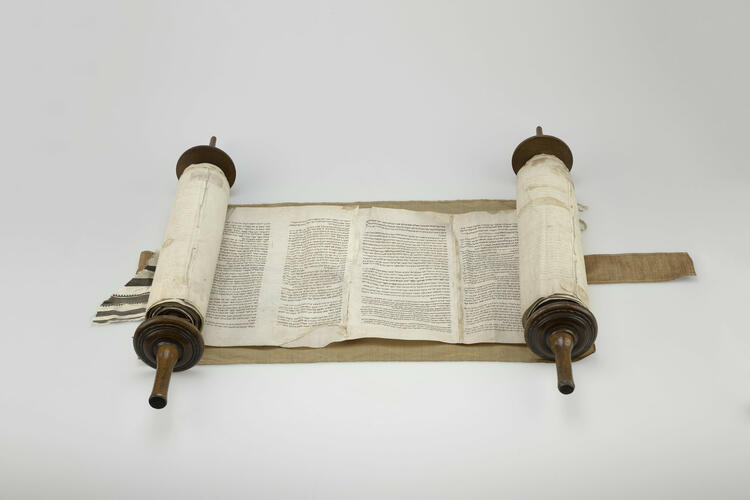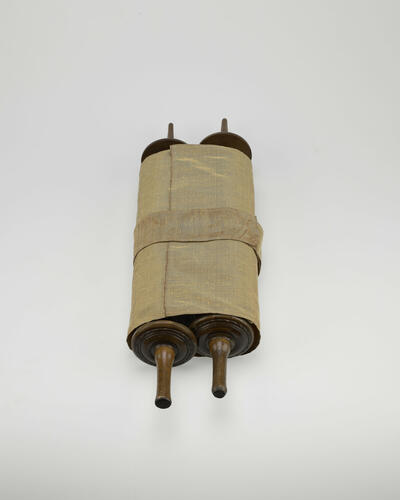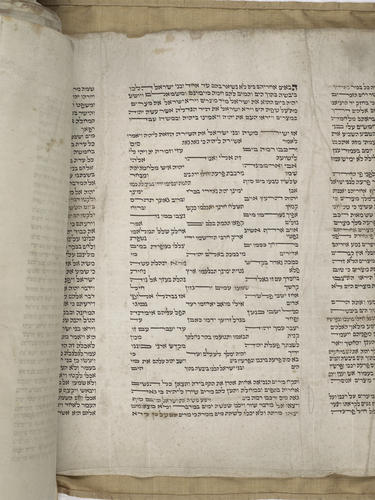-
1 of 253523 objects
Sefer Torah 1830
36 x 2742.91 cm (vellum sheet) | RCIN 1123995
-
Books are central to the Jewish faith. The most important is The Torah, which contains the Old Testament books of Genesis, Exodus, Leviticus, Numbers and Deuteronomy. The text is sung, rather than read, in synagogue services over the course of a year and its completion is marked by Simchat Torah, a joyous celebration with much singing and dancing.
This Torah Scroll was written in the 1830s for a Jewish community in Bohemia. It was housed in the Pinkas Synagogue in the Jewish Quarter in Prague. Founded in 1535, this is the second oldest synagogue in Prague, and it is now a memorial to the 78,000 Czech Jewish victims of the Shoah, or the Holocaust.
Jewish communities had lived in the Czech lands for millennia. The Jewish Museum in Prague, founded in 1906, chronicled their life. Following Hitler’s annexation of Czechoslovakia in March 1939, Jewish communities were instructed to send precious objects from their synagogues, including Torah Scrolls, to Prague. The objects filled 40 warehouses. The staff at the Jewish Museum catalogued all of them before being deported to Nazi Concentration Camps.
After the Second World War, the Scrolls were stored in a ruined synagogue outside Prague. The Czech Communist government offered them for sale to Israel, unsuccessfully, and then approached a London art dealer. Through the efforts of British scholars, art dealers and collectors, 1,564 Scrolls were purchased and moved to London’s Westminster Synagogue in 1964. A charity, the Memorial Scrolls Trust, was set up to conserve the Scrolls and place them on deposit with Jewish communities across the world.
This is the only Torah Scroll donated by the Memorial Scrolls Trust. It was presented to Queen Elizabeth II by Rabbi Dr Albert Friedlander as a gift for the Royal Library at Windsor in 1981.
This Torah Scroll is made up of 51 sheets of fine parchment (animal skin) that have been sewn together. The text is spread across 182 columns; the number of columns per sheet of parchment varies throughout the Scroll, but is usually either three or four. The number of lines per column ranges between 42 and 46 lines. Throughout the Scroll there are filaments, also known as crowns, on the tops of the letters. Vowel accents, punctuation and cantillation marks are absent, as is common in Torah Scrolls. At least three scribes were responsible for the text. The manuscript is still attached to the rollers and the handles are thought to be made of beech wood. The Scroll is wrapped in cloth (mappah) of yellow silk.
Provenance
A gift to Queen Elizabeth II, 1981, to be kept in the Royal Library, by the Memorial Scrolls Committee, Westminster Synagogue, London
-
Creator(s)
(sofer)Acquirer(s)
-
Measurements
36 x 2742.91 cm (vellum sheet)
Category




